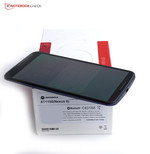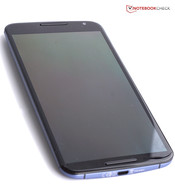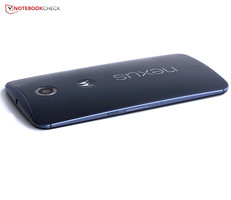Recensione breve dello Smartphone Google Nexus 6 (Motorola XT1100-M0E10)
| |||||||||||||||||||||||||
Distribuzione della luminosità: 89 %
Al centro con la batteria: 274 cd/m²
Contrasto: ∞:1 (Nero: 0 cd/m²)
ΔE ColorChecker Calman: 6.99 | ∀{0.5-29.43 Ø4.78}
ΔE Greyscale Calman: 4.01 | ∀{0.09-98 Ø5}
Gamma: 2.03
CCT: 6329 K
| Google Nexus 6 Adreno 420, 805 APQ8084, 32 GB eMMC Flash | Apple iPhone 6 Plus PowerVR GX6450, A8, 64 GB eMMC Flash | Huawei Ascend Mate 7 Mali-T628 MP6, Kirin 925, 16 GB eMMC Flash | Nokia Lumia 1520 Adreno 330, 800 MSM8974, 32 GB eMMC Flash | Samsung Galaxy Note 4 Adreno 420, 805 APQ8084, 32 GB eMMC Flash | Acer Liquid S2 Adreno 330, 800 MSM8974, 16 GB eMMC Flash | |
|---|---|---|---|---|---|---|
| Screen | 46% | 47% | 40% | 35% | 33% | |
| Brightness middle (cd/m²) | 274 | 519 89% | 451 65% | 421 54% | 335 22% | 435 59% |
| Brightness (cd/m²) | 264 | 496 88% | 455 72% | 399 51% | 339 28% | 406 54% |
| Brightness Distribution (%) | 89 | 90 1% | 93 4% | 86 -3% | 92 3% | 88 -1% |
| Black Level * (cd/m²) | 0.62 | 0.46 | 0.48 | 0.25 | ||
| Colorchecker dE 2000 * | 6.99 | 3.67 47% | 2.49 64% | 3.28 53% | 1.77 75% | 3.59 49% |
| Greyscale dE 2000 * | 4.01 | 3.78 6% | 2.88 28% | 2.28 43% | 2.06 49% | 3.83 4% |
| Gamma | 2.03 108% | 2.42 91% | 2.5 88% | 2.41 91% | 2.61 84% | |
| CCT | 6329 103% | 7327 89% | 6936 94% | 6424 101% | 6491 100% | |
| Contrast (:1) | 837 | 980 | 877 | 1740 | ||
| Color Space (Percent of AdobeRGB 1998) (%) | 99 |
* ... Meglio usare valori piccoli
| Geekbench 3 | |
| 32 Bit Multi-Core Score (ordina per valore) | |
| Google Nexus 6 | |
| Apple iPhone 6 Plus | |
| Huawei Ascend Mate 7 | |
| Samsung Galaxy Note 4 | |
| Acer Liquid S2 | |
| 32 Bit Single-Core Score (ordina per valore) | |
| Google Nexus 6 | |
| Apple iPhone 6 Plus | |
| Huawei Ascend Mate 7 | |
| Samsung Galaxy Note 4 | |
| Acer Liquid S2 | |
| Smartbench 2012 | |
| Productivity Index (ordina per valore) | |
| Google Nexus 6 | |
| Samsung Galaxy Note 4 | |
| Acer Liquid S2 | |
| Gaming Index (ordina per valore) | |
| Google Nexus 6 | |
| Samsung Galaxy Note 4 | |
| Acer Liquid S2 | |
| AnTuTu v5 - Total Score (ordina per valore) | |
| Google Nexus 6 | |
| Apple iPhone 6 Plus | |
| Huawei Ascend Mate 7 | |
| Samsung Galaxy Note 4 | |
| Acer Liquid S2 | |
* ... Meglio usare valori piccoli
| 3DMark | |
| 1280x720 offscreen Ice Storm Unlimited Score (ordina per valore) | |
| Google Nexus 6 | |
| Apple iPhone 6 Plus | |
| Huawei Ascend Mate 7 | |
| Samsung Galaxy Note 4 | |
| Acer Liquid S2 | |
| 1280x720 offscreen Ice Storm Unlimited Graphics Score (ordina per valore) | |
| Google Nexus 6 | |
| Apple iPhone 6 Plus | |
| Huawei Ascend Mate 7 | |
| Samsung Galaxy Note 4 | |
| Acer Liquid S2 | |
| 1280x720 offscreen Ice Storm Unlimited Physics (ordina per valore) | |
| Google Nexus 6 | |
| Apple iPhone 6 Plus | |
| Huawei Ascend Mate 7 | |
| Samsung Galaxy Note 4 | |
| Acer Liquid S2 | |
| GFXBench (DX / GLBenchmark) 2.7 | |
| T-Rex Onscreen (ordina per valore) | |
| Google Nexus 6 | |
| Apple iPhone 6 Plus | |
| Nokia Lumia 1520 | |
| Samsung Galaxy Note 4 | |
| Acer Liquid S2 | |
| 1920x1080 T-Rex Offscreen (ordina per valore) | |
| Google Nexus 6 | |
| Apple iPhone 6 Plus | |
| Nokia Lumia 1520 | |
| Samsung Galaxy Note 4 | |
| Acer Liquid S2 | |
| GFXBench 3.0 | |
| on screen Manhattan Onscreen OGL (ordina per valore) | |
| Google Nexus 6 | |
| Apple iPhone 6 Plus | |
| Huawei Ascend Mate 7 | |
| Samsung Galaxy Note 4 | |
| 1920x1080 1080p Manhattan Offscreen (ordina per valore) | |
| Google Nexus 6 | |
| Apple iPhone 6 Plus | |
| Huawei Ascend Mate 7 | |
| Samsung Galaxy Note 4 | |
| Sunspider - 1.0 Total Score (ordina per valore) | |
| Google Nexus 6 | |
| Apple iPhone 6 Plus | |
| Huawei Ascend Mate 7 | |
| Nokia Lumia 1520 | |
| Samsung Galaxy Note 4 | |
| Acer Liquid S2 | |
| Octane V2 - Total Score (ordina per valore) | |
| Google Nexus 6 | |
| Apple iPhone 6 Plus | |
| Huawei Ascend Mate 7 | |
| Samsung Galaxy Note 4 | |
| Acer Liquid S2 | |
| Mozilla Kraken 1.1 - Total (ordina per valore) | |
| Google Nexus 6 | |
| Apple iPhone 6 Plus | |
| Huawei Ascend Mate 7 | |
| Nokia Lumia 1520 | |
| Samsung Galaxy Note 4 | |
| Acer Liquid S2 | |
| Google V8 Ver. 7 - Google V8 Ver. 7 Score (ordina per valore) | |
| Google Nexus 6 | |
| Apple iPhone 6 Plus | |
| Nokia Lumia 1520 | |
| Samsung Galaxy Note 4 | |
| Acer Liquid S2 | |
* ... Meglio usare valori piccoli
| AndroBench 3-5 | |
| Sequential Read 256KB (ordina per valore) | |
| Google Nexus 6 | |
| Huawei Ascend Mate 7 | |
| Samsung Galaxy Note 4 | |
| Acer Liquid S2 | |
| Sequential Write 256KB (ordina per valore) | |
| Google Nexus 6 | |
| Huawei Ascend Mate 7 | |
| Samsung Galaxy Note 4 | |
| Acer Liquid S2 | |
| Random Read 4KB (ordina per valore) | |
| Google Nexus 6 | |
| Huawei Ascend Mate 7 | |
| Samsung Galaxy Note 4 | |
| Acer Liquid S2 | |
| Random Write 4KB (ordina per valore) | |
| Google Nexus 6 | |
| Huawei Ascend Mate 7 | |
| Samsung Galaxy Note 4 | |
| Acer Liquid S2 | |
| BaseMark OS II - Memory (ordina per valore) | |
| Google Nexus 6 | |
| Apple iPhone 6 Plus | |
| Nokia Lumia 1520 | |
| Samsung Galaxy Note 4 | |
| Acer Liquid S2 | |
| PassMark PerformanceTest Mobile V1 - Disk Tests (ordina per valore) | |
| Google Nexus 6 | |
| Apple iPhone 6 Plus | |
| Samsung Galaxy Note 4 | |
| Acer Liquid S2 | |
(±) La temperatura massima sul lato superiore è di 40.7 °C / 105 F, rispetto alla media di 35.2 °C / 95 F, che varia da 21.9 a 247 °C per questa classe Smartphone.
(+) Il lato inferiore si riscalda fino ad un massimo di 39.5 °C / 103 F, rispetto alla media di 34 °C / 93 F
(+) In idle, la temperatura media del lato superiore è di 28.8 °C / 84 F, rispetto alla media deld ispositivo di 32.9 °C / 91 F.
| Off / Standby | |
| Idle | |
| Sotto carico |
|
Leggenda:
min: | |
| Google Nexus 6 Adreno 420, 805 APQ8084, 32 GB eMMC Flash | Apple iPhone 6 Plus PowerVR GX6450, A8, 64 GB eMMC Flash | Huawei Ascend Mate 7 Mali-T628 MP6, Kirin 925, 16 GB eMMC Flash | Nokia Lumia 1520 Adreno 330, 800 MSM8974, 32 GB eMMC Flash | Samsung Galaxy Note 4 Adreno 420, 805 APQ8084, 32 GB eMMC Flash | Acer Liquid S2 Adreno 330, 800 MSM8974, 16 GB eMMC Flash | |
|---|---|---|---|---|---|---|
| Autonomia della batteria | 25% | 49% | 24% | 53% | -1% | |
| Reader / Idle (h) | 19.2 | 23.9 24% | 24.3 27% | 27.8 45% | 16.3 -15% | |
| H.264 (h) | 10.9 | 11.3 4% | 14.6 34% | 11.7 7% | 4.6 -58% | |
| WiFi (h) | 10 | 13 30% | 11.5 15% | 9.7 -3% | 12.4 24% | 14.1 41% |
| Load (h) | 2.3 | 3.3 43% | 4.2 83% | 3.2 39% | 5.4 135% | 3 30% |
Il Nexus 6 è un phablet della serie Nexus: robusto, bello e veloce con qualche piccola pecca.
Come gli altri Nexus, si usano componenti ben conosciuti e si tende a non essere i migliori per limitare i costi. Questo si nota con la fotocamera: che scatta foto decenti, ma gli smartphones high-end fanno molto meglio. L'autonomia del Google Nexus 6 non batte alcun record. Lo schermo high-resolution dovrebbe avere maggiore precisione con i colori, per il resto, abbiamo apprezzato le qualità AMOLED come il nero e gli angoli di visuale.
Buone le casse frontali, le temperature basse ed il case sofisticato - sebbene attira le ditate - bena anche il velocissimo SoC. Il Google Nexus 6 è eccellente per il gaming ed attualmente non ci sono apps che possono stressare il processore. Non c'è molto spazio per miglioramenti dei moduli di comunicazione e l'utilizzo ed il software sono molto semplici.
Sebbene Google e Motorola lavorino facendo del loro meglio, non è ancora abbastanza per meritare un punteggio "molto buono". Tuttavia, con un update della feature "Ambient Display", il Nexus 6 potrebbe essere quasi un perfetto phablet Android.
Nota: si tratta di una recensione breve, con alcune sezioni non tradotte, per la versione integrale in inglese guardate qui.




















